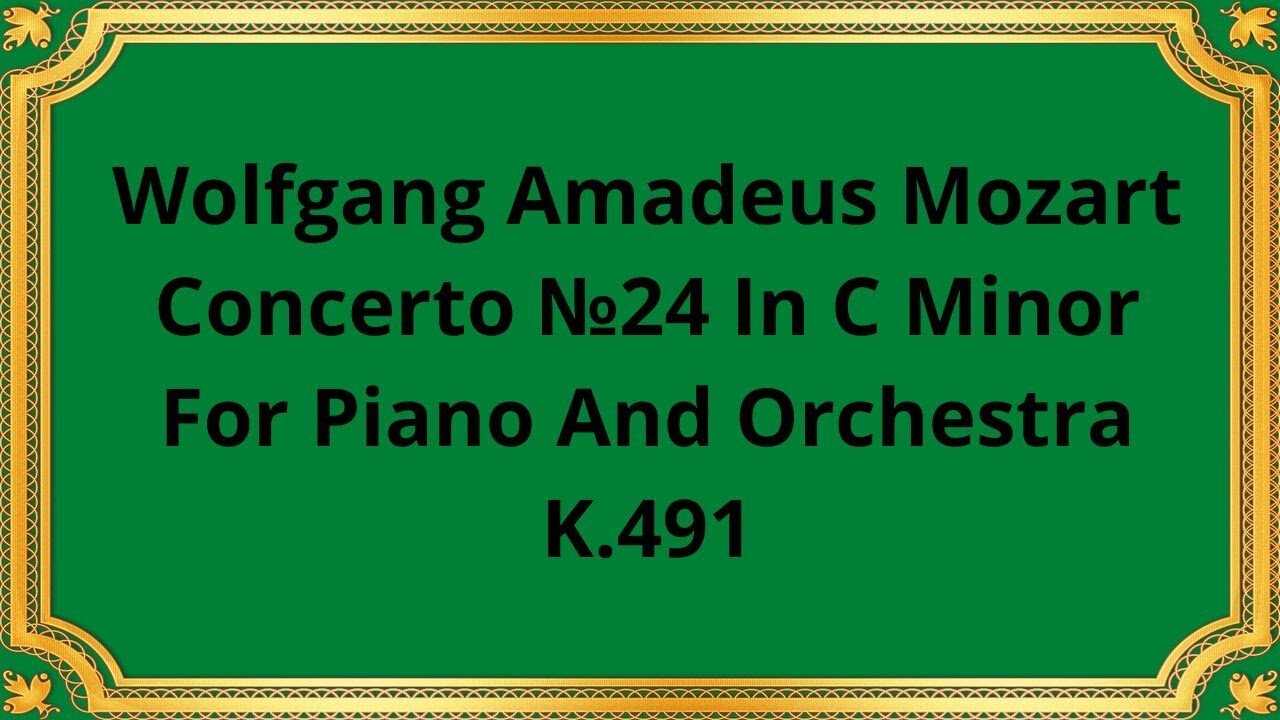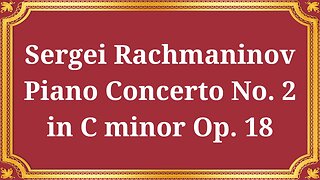Premium Only Content

Wolfgang Amadeus Mozart Concerto №24 In C Minor For Piano And Orchestra, K.491
#Mozart #ClassicalMusic #ConcertoNo24 #CMinor #Piano #Orchestra #MusicComposition #K491 #Musician #Composer #MusicHistory #MusicPerformance #MusicAppreciation #MusicEnthusiast #MusicalGenius #BaroqueMusic #ClassicalPeriod #Mozartian #OrchestralMusic #PianoConcerto
Publication date 1965
PAUL VON SCHILHAWSKY, PIANO UNDER THE DIRECTION OF RUDOLF ALBERT
Wolfgang Amadeus Mozart, an iconic figure in the realm of classical music, gifted the world with a vast collection of masterpieces. Among his remarkable works, Concerto No. 24 in C Minor for Piano and Orchestra, K.491, stands as a testament to his genius and artistic prowess.
Composed in 1786, during a period of great artistic maturity for Mozart, Concerto No. 24 reflects the composer's ever-evolving musical style. This concerto emerged during the height of the Classical period, a time characterized by a shift towards emotional depth, expressiveness, and exploration of new musical territories. Mozart's composition stands as a testament to his ability to push boundaries and captivate audiences with his innovative approach.
Concerto No. 24 unfolds in three movements, adhering to the traditional concerto form. The opening movement, Allegro, immerses listeners in a world of intensity and drama. The piano and orchestra engage in a passionate dialogue, exploring contrasting themes and showcasing Mozart's ability to intertwine complex melodies with harmonic richness.
The second movement, Larghetto, provides a stark contrast to the preceding movement. This introspective and lyrical section captivates the listener with its tender melodies and delicate interplay between the piano and orchestra. Mozart's gift for crafting emotionally evocative passages shines through, enveloping the audience in a profound sense of melancholy and introspection.
The final movement, Allegretto, bursts forth with a sense of urgency and vigor. It showcases Mozart's unparalleled command of form and structure, as the piano and orchestra engage in a spirited conversation, trading virtuosic passages and intricate musical motifs. The movement builds to a climactic finale, leaving listeners in awe of Mozart's technical brilliance and compositional prowess.
Concerto No. 24 in C Minor evokes a wide range of emotions within its listeners. The first movement, with its dramatic and intense character, invites listeners into a world of turmoil and passion. The second movement, in contrast, touches the depths of the soul with its melancholic and introspective melodies, evoking a sense of longing and introspection. The final movement, with its energetic and virtuosic passages, leaves audiences exhilarated and amazed by Mozart's sheer brilliance and mastery of composition.
Conclusion:
Mozart's Concerto No. 24 in C Minor, K.491, stands as a testament to his ability to push the boundaries of musical expression and captivate audiences with his innovative approach. Its historical significance, intricate musical structure, and emotional impact make it a true masterpiece of the Classical period. Whether experienced in a concert hall or through recordings, this concerto continues to resonate with listeners, reminding us of Mozart's enduring legacy as one of the greatest composers in the history of classical music.
You have the opportunity to support the channel:
https://destream.net/live/RadSiarAl/donate
https://www.buymeacoffee.com/6355radsiaral
-
 34:38
34:38
Classical music_Music Inspiration
1 month agoSergei Rachmaninov Piano Concerto No. 2 in C minor Op. 18
80 -
 3:34
3:34
The Official Steve Harvey
16 hours ago $0.81 earnedCelebrity LOLs: Behind-the-Scenes Laughs and Unfiltered Moments with Your Favorite Stars!
4.9K2 -
 8:06
8:06
ariellescarcella
1 day ago"Be Queer, Do Crime" : How About NO
5.08K6 -
 4:31
4:31
The Shannon Joy Show
13 hours ago💣Economic Detonation! Is Trump Making It Worse_ Prepare NOW!
5.26K6 -
 9:51
9:51
Alabama Arsenal
11 hours ago $0.26 earnedRXD30Ti
4.83K1 -
 20:06
20:06
The Why Files
4 days agoSTRIPPED: When Earth's Shield Fails the Dead Will Rise | The Plasma Apocalypse
196K116 -
 12:26
12:26
EvenOut
14 hours ago $12.03 earnedWe Got Cosmestic Surgery That Went Wrong! Twin Switch-Up!
58.8K11 -
 1:15:07
1:15:07
Ami's House
20 hours ago $10.38 earnedWhat an ACTUAL Military Expert Thinks of the War in Gaza – Nick Freitas | FULL EP
37.2K23 -
 2:54:02
2:54:02
TimcastIRL
12 hours agoLiberal Media CAUGHT In BOGUS LEAK, Trump DID NOT Fire Mike Waltz, HE PROMOTED HIM | Timcast IRL
249K137 -
 9:05:24
9:05:24
MyronGainesX
19 hours ago $29.58 earnedSam Seder Embarrasses Ethan Klein, The Truth On MLK's Murder, Panel Debate w/ Anton Daniels
91.5K35